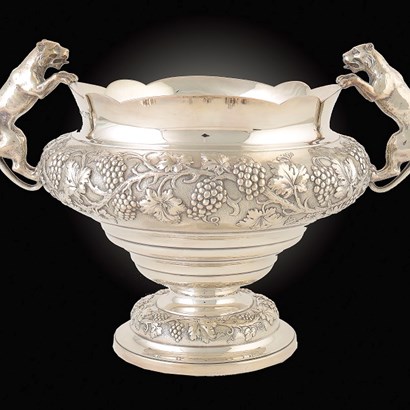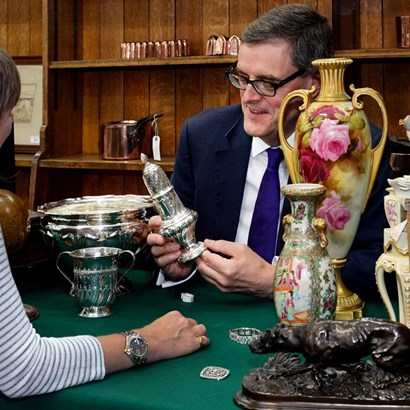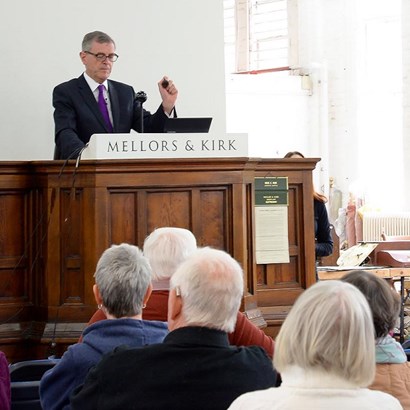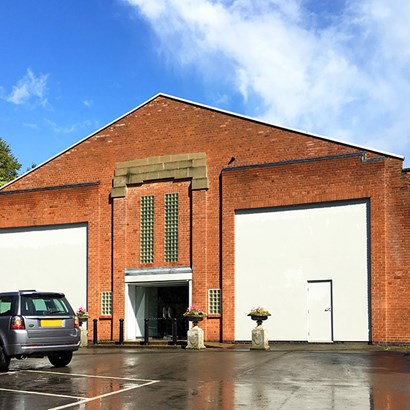Auction Insights
Craftsmen
In a recent interview entrepreneur Sir James Dyson spoke of the coming “Fourth Industrial Revolution” and how he would like Britain to become like Singapore. I am not so sure about that, but he also pointed out that Britian will be “a million engineers short in three year’s time.” In the 19th century towns such as Nottingham could boast a welter of artisan-engineers and craftsmen-shopkeepers in all trades – take clockmaking for example.
The stunning Victorian brass ‘skeleton’ clock dating from 1860 at Sotheby’s which caught my eye this week carries the name plaque of ‘Everington Nottingham’. Designed as Westminster Abbey, it has a triple fusee chiming movement and all eight bells are disguised in the Abbey’s towers. Standing on a marble base beneath a glass dome it is 66cm high and would have been an impressive feature of Alfred Everington’s shop in Nottingham’s Victoria Street.
A Lincolnshire man, he was born in 1830 and apprenticed to clockmaker George Pearce, whose shop was at 11 Pelham Street. Alfred was afterwards foreman of the watch and clock workshop before setting up on his own. Many of his clocks and watches, together with other lines such as jewellery, were bought in for resale, but Everington was a fully time served clockmaker whose advice would have been invaluable. Such shops usually had one particularly impressive marvel of horology – perhaps a longcase regulator with a high precision deadbeat movement or a skeleton clock such as this example – really intended for display and to draw in the customers. His clock most recently belonged to Lord Ballyedmond, another entrepreneur, who tragically died in a helicopter crash in Norfolk in 2014. It was estimated to fetch £8000-12000 and sold on Wednesday for £12,250.
Once there were 260 clock and watchmakers in Nottingham of which around 80 actually made rather than simply finished, or supplied them. One of the earliest known, created an amazing timepiece that was also seen at Sotheby’s recently. Dating from the reign of Queen Anne circa 1705, it is a pocket watch of superb quality that has several important features. It would have cost a fortune even at a period when only the very wealthiest could contemplate buying a watch. Every part of it is beautifully hand made. This example is extremely rare in having a differential dial, one for the hours and the other for telling the minutes. Only recently had it become possible to obtain a watch that boasted a minutes hand in addition to an hour hand. The maker, James Banks possibly thought that the new fangled arrangement of two hands on one dial was confusing. Needless to say his idea did not catch on. Only a couple of other examples are known, one of which is in the British Museum.
This wonderful piece of Nottingham craftsmanship went to a lucky bidder for almost the same price as Everington’s skeleton clock, but still much less than many people spend on a factory-made Rolex or other high end watch when they go shopping today. Such, it may be said, is the triumph of a brand name and global marketing over a master craftsman creating wonders at his workbench.
Banks and Everington, although separated by a 150 years were engineers who have left behind objects on which they would have been proud to have put their name. They were, in their respective times, not that unusual, no doubt living over the shop, or if prospering moving a little further out of the still small town. These and many others possessed what can seem a bewildering range of exceptional skills. Many were immigrants, for example the Huguenots of Spitalfields, or dissenters. It is no coincidence the three greatest British clockmakers in history, including Thomas Tompion (1636-1713) were Quakers.
Napoleon is thought to have described Britain as ‘a nation of shopkeepers,’ but I think he meant ‘workshops’. That’s surely an acknowledgment of that the nation’s mercantile pre-eminence was founded on generations of engineers and other ‘makers’, such as these local worthies.
Wheels of a quite different kind are to be found on another object from Nottingham’s past, a builder’s handcart from Wilford, made in about 1920. Once a common sight and a feature of old photographs and postcards, the very ‘ordinariness’ of such objects means people did not generally think them worth preserving. Why should anyone wish to be reminded of pushing, or pulling a decidedly heavy cartload of building materials, ladders and tools over cobbled streets when motor power became available. It puts me mind of the Hovis advert and New World Symphony.
You can clearly make out the original painted inscription – ‘Weightman Wilford’. According to the local owner he was Herbert Weightman (1884-1955). Born at North Muskham near Newark, he was the youngest of four children and was apprenticed in the building trade before becoming a member of the Operative Society of Bricklayers. He moved to Wilford in 1921 to be near his two sisters and would have been a familiar sight, building and repairing houses in Wilford, many of which are still standing. In World War II he was sent to Bedford to help in the construction of aircraft hangers. His cart was a genuine ‘barn find’ when its owner, Weightman’s great nephew, found it locked away in its shed in the 1960s.
A genuine piece of local history, I hope whoever buys it will sensitively conserve rather than over restore it. It goes under the hammer at the Auction House on 22nd June with an estimate of £200-300o vH
< Back to Auction Insights



